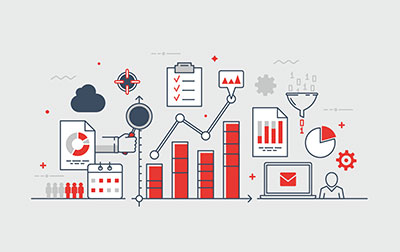Unlocking the power of information management: Beyond documents

Today, information or data exists in various digital formats that can be processed, integrated, and transmitted electronically. Digital information can include text, images, audio, video, 3D graphical models, databases and more. To harness this proliferation of data, organizations and clients need to rethink their approach to managing information and adopt a digital mindset based on their information requirement.
Non-digital delivery methods can lead to several pitfalls when it comes to managing large complex projects, including but not limited to:
- Version Control Issues: Keeping track of the most recent version of documents and drawings can be challenging, leading to confusion and potential errors if outdated versions are used.
- Accessibility Concerns: Physical documents and drawings may not be easily accessible to all project stakeholders, especially if they are in different geographic locations or working remotely in separate digital environments.
- Limited Collaboration: Traditional formats often hinder real-time collaboration, making it difficult for team members to work together efficiently and contribute to the project simultaneously.
- Storage and Retrieval Challenges: Storing and retrieving large volumes of documents and drawings can be time-consuming and inefficient, especially as the project progresses and the amount of information increases.
- Risk of Errors: Manually updating and distributing documents and drawings increases the risk of errors, such as incorrect information being included, or important updates being missed.
- Lack of Interactivity and Integration: Traditional formats make it difficult for stakeholders to interact with the information dynamically or analyze it in different ways.
- Environmental Impact: Printing and distributing large quantities of documents and drawings can have a significant environmental impact in terms of paper usage, printing resources, and transportation.
In today’s digital project delivery methodology, the role of IM is to ensure project alignment, minimize misunderstandings, and allow for informed decision-making. Without effective information management, there is a higher risk of communication breakdowns, delays, and errors, which can ultimately lead to unsuccessful project outcomes. It's about ensuring that all stakeholders have the necessary information to do their jobs effectively and keep the project on track.
IM is also a framework for the production and delivery of information for capital delivery and operation of assets, which was codified through the ISO 19650 standard in 2018. This framework helps establish a golden thread of data from the start of a project to the completion, not just during design, or during construction, but into operations, maintenance, and asset renewal. This is achieved throughout project delivery by creating a structured Project Information Model (PIM), a collection of highly organized files that can be viewed in multiple ways. Over time a PIM can also be developed into an Asset Information Model (AIM), which contains a subset of that information necessary to effectively run an operation for the life of an asset, and is often the foundation needed for standing up a digital asset and digital twin. It's a hugely ambitious concept, but one that revolutionizes how owners manage the capital delivery and operations of their assets and make the right decisions for the long term.
Best practice is to have a team that is solely responsible for the management of information and is responsible for:
- Information Governance: all the standards, procedures, and quality assurance that supports the overall IM framework
- Building Information Management (BIM): supports design, production, and collaboration and a wide range of digital use cases, including 3D through 7D and beyond
- Document Management: provides control and delivery of information
- Project Systems: management of common data environments and tools, ensuring information flows with integrity between them
- Information Technology: infrastructure and cybersecurity support wherever it’s needed
- Asset Management: maximizing performance and level of service from assets
The sheer amount of information that is generated and managed on projects has dramatically increased in recent years. Digital project delivery today requires the development of massive graphical models that are connected to large databases of information, which may be streamed over the web in a GIS platform or viewed through a virtual reality headset that requires secure infrastructure. And so, while Document Management is still core to Information Management, it is only one part of what is involved in most large projects today.
As an owner/operator, it is important to establish project requirements to enable better operational management for the life of their facility, which could be 50 to 100 years. Addressing what information is required to safely operate, maintain, and optimize their operations is key. This requires a lot of up-front engagement and foresight to get this right.
It is a significant effort, but it pays long-term dividends because IM is fundamentally about enabling the right decisions to be made. When you make the right decision, you eliminate risk and waste. To make the right decision, you need the right information, and to get the right information you need good quality data that is processed efficiently into the right information. To get the right data that you can trust and rely on, you need to be working within a strong information management framework, with the right standards and processes in place. Fundamentally, you need to be working with common data that is shared and accessible to those who need it, when they need it. This brings us to the all-important concept of a Common Data Environment (CDE).
The CDE concept is simply everyone working in the same place with the same information (the same tools and data), so there are no barriers to effective collaboration and information sharing. It sounds simple, but in today’s industry, where everyone is working with global partners, many employees are still working remotely, teams are spread globally, it is extremely difficult to get everyone working in a single place, with a common set of tools. When you work in separate environments, everything slows down because information transfer is slow and imperfect, workflows are different, collaboration and communication breaks down, things fall between the cracks, projects suffer and, the wrong decisions get made leading to re-work and less than optimal solutions to client operations.
That’s why Hatch has invested heavily in the development of its own CDE, and in building outward-facing CDE for multiple party coordination pursuant to ISO 19650. This will allow our teams to effectively collaborate with one another and with our global partners and clients. Working together across corporate and IT boundaries – with common workflows and toolsets – allows us to be one team, with one way of working, in one environment.
Ultimately, IM is about more than just managing documents; it is about unlocking the full potential of digital transformation and enabling organizations to make informed decisions that drive long-term success. As the digital landscape continues to evolve, organizations that embrace IM will be well-positioned to thrive in the years to come.
At Hatch, our holistic approach ensures information is managed effectively across projects and provides clients and stakeholders with a single point of contact for all information-related needs.
By identifying information delivery requirements from the outset, organizations can lay the groundwork for success and ensure that the right information is available to the right person, at the right time.
Contact us to find out more about digital transformation at Hatch and best practices for managing data.
Listen to our podcast with Andy Hares, Information Management – it's more than just documents!
